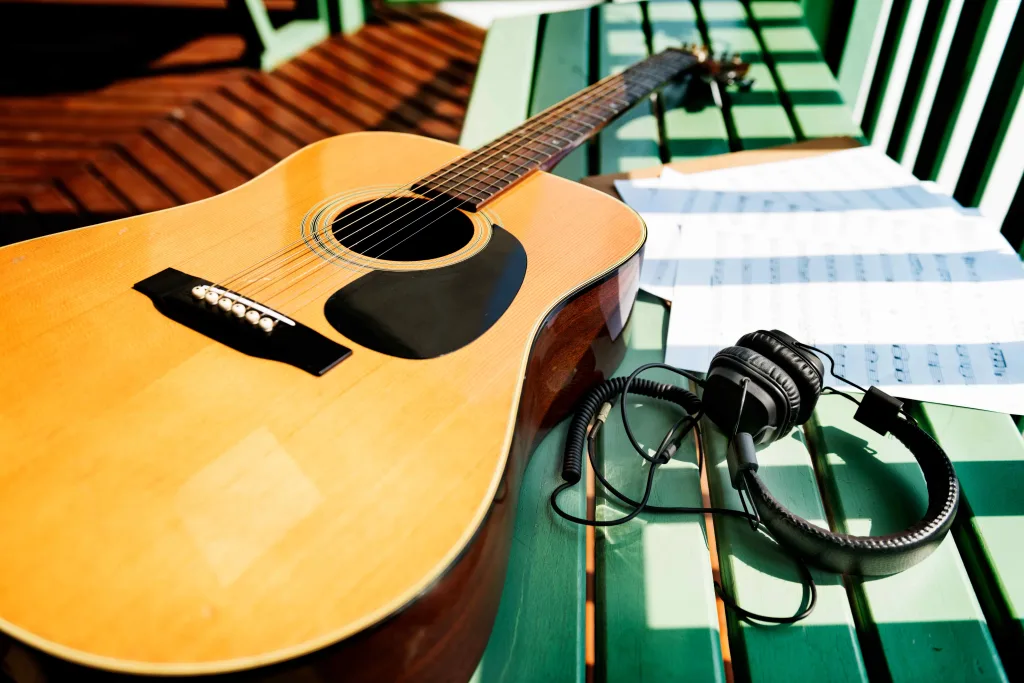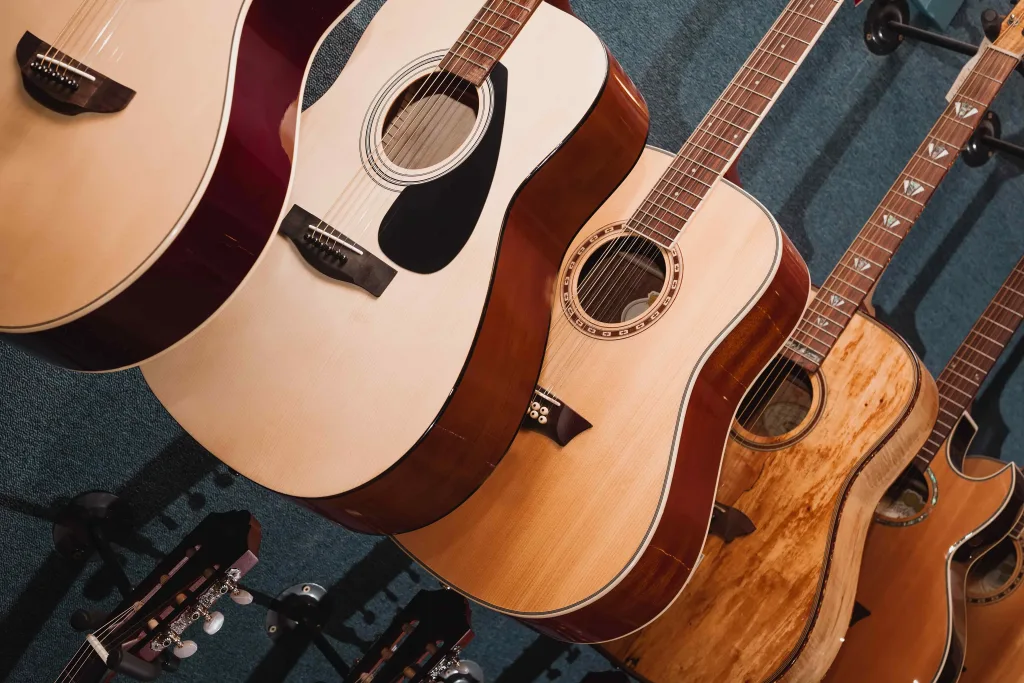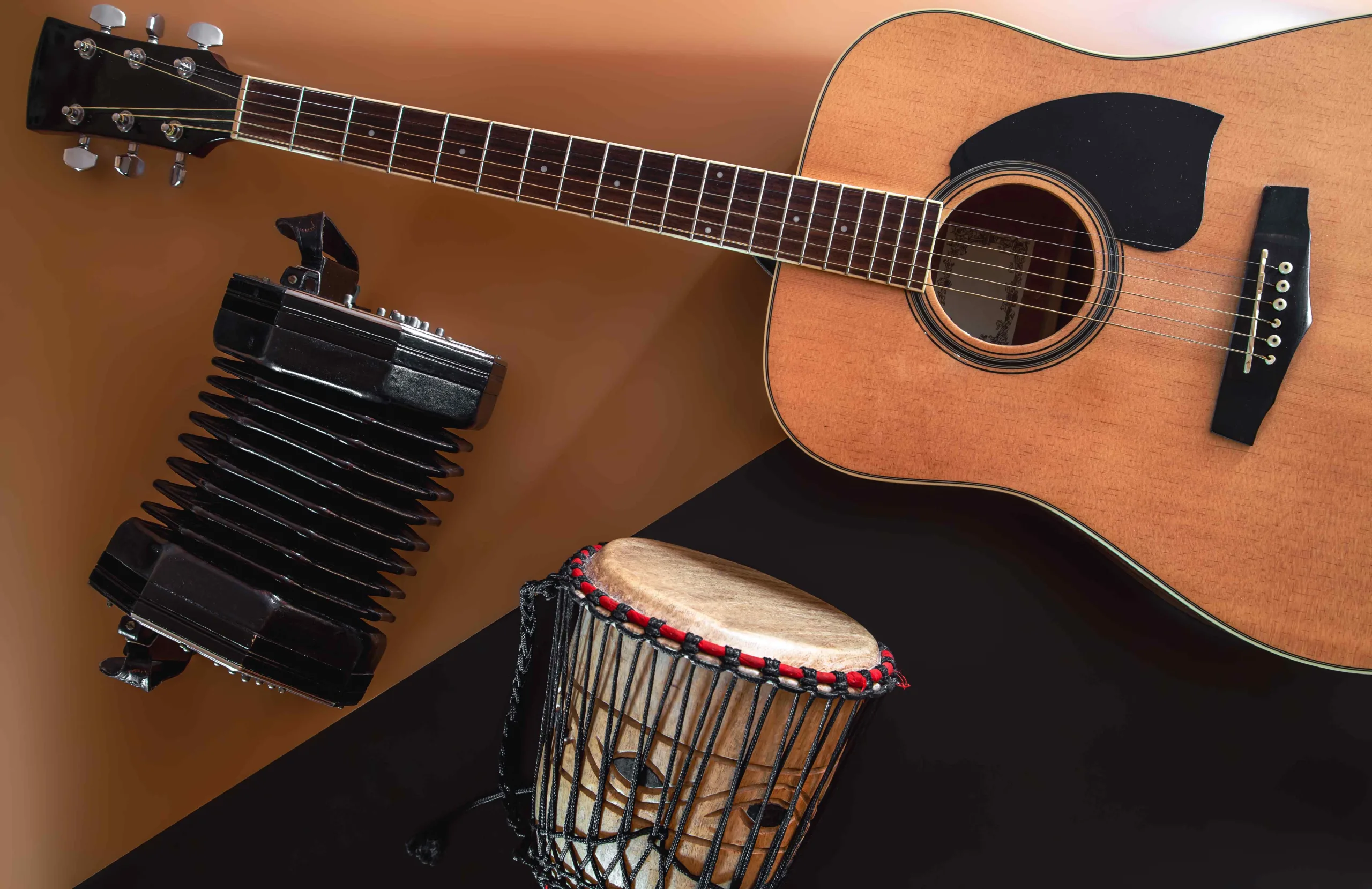The dreadnought guitar is a famous and beloved type of acoustic or electro-acoustic guitar. It’s the go-to choice for many musicians because it embodies the essence of what an acoustic guitar should be.
Its simple design and strong sound projection have made it a favorite in the music world. In this article, we’ll delve into the characteristics, origins, and reasons why the dreadnought guitar is so highly regarded.
What is a Dreadnought Guitar?
Dreadnought guitar is known for its big and simple body shape. It usually doesn’t have any cutaways, but there are versions with single-cutaway available. The lack of cutaways means there’s more space for the soundboard, which gives it a rich and full sound.
The large size of the dreadnought guitar allows it to be loud and produce warm tones, making it great for strumming and flat-picking styles.
A Brief History of the Dreadnought Guitar
The first dreadnought guitar was created by Martin in the early 1900s. The name “dreadnought” came from a type of battleship used by the British Navy.
The early dreadnought guitars made by Martin were quite different from the ones we see today. It wasn’t until 1931 that Martin introduced the D-2 model, which closely resembled the modern dreadnought guitars we’re familiar with.
These guitars were made of rosewood, a lightweight wood known for its bright and vibrant tone. This was a departure from the previous dreadnoughts, which were often made from mahogany.
Since then, many other guitar manufacturers have adopted the classic dreadnought body shape and created their own models.
For instance, Gibson has the Songbird with its famous “burst” finish and intricate pickguard design similar to their Les Paul models. Other well-known brands like Fender (and Epiphone), Yamaha, and Sigma have also produced their own dreadnought guitars at different price ranges.
Pros and Cons of the Dreadnought Guitar

Pros of the Dreadnought Guitar
Dreadnought acoustic guitars have several advantages that make them a top choice for musicians.
Dreadnoughts Deliver a Big and Powerful Sound
Dreadnoughts deliver a big and powerful sound with a deep and thick tone. Their larger size allows them to produce high volume and emphasize bass and mid-range tones, making them perfect for rhythmic and percussive playing. They can even fill in as a substitute for the bass in acoustic band performances, providing a strong foundation for the rhythm section.
Extended Neck Reach
The extended neck reach of the dreadnought’s guitar allows for easy access to higher frets compared to other acoustic or semi-acoustic guitars. With the neck cutoff at the 14th fret, you can play intricate chords like triads and jazz chords. It also enables you to perform higher solos in acoustic songs.
Dreadnought guitars maintain excellent sustain and resonance across the entire fretboard, ensuring a balanced sound from low to high notes.
Wide Range of Options
The wide range of options available to suit different budgets and preferences makes the dreadnought guitar so popular. You can explore various brands, models and even have a custom-built dreadnought designed specifically for you by a manufacturer.
Cons of the Dreadnought Guitar
There are a few things to consider before choosing the dreadnought guitar.
Dreadnoughts are larger guitars
Dreadnoughts are larger guitars, and their deep and wide body shape may not be comfortable for everyone to play. It’s important to try out a dreadnought guitar in a store to see if it feels right in your hands before buying one.
Dreadnought guitars can be too loud
Dreadnought guitars can be too loud in certain situations. If you’re playing in a room with a lot of echoes or need to play at a lower volume to fit with a band, the dreadnought’s volume might become overpowering. Similarly, if you want to practice quietly at home, the loudness of a dreadnought can be a challenge.
Playing with other musicians may create a muddy sound
When playing with other musicians, especially bassists, the deep bass tones of the dreadnought guitar can sometimes create a muddy sound in the lower range. The bass frequencies from both instruments can clash, making the overall sound less clear.
Steel strings can be harder on the fingertips
Steel strings can be harder on the fingertips compared to nylon strings, which may cause initial discomfort. However, as you develop calluses on your fingertips over time, this issue becomes less of a problem.
It’s important to consider these factors and think about your playing style, preferences, and specific needs to decide if a dreadnought guitar is the right choice for you.
Common Types of Dreadnought Guitars

Let’s explore the common types of dreadnought guitars that might catch your interest.
Cutaway Dreadnought Guitars
Cutaway Dreadnought Guitars have an extended reach to higher frets, allowing easier access to the fingerboard. Cutaways are common in other acoustic guitars as well. They are beneficial for both rhythm playing and soloing, particularly favored by lead guitarists who want to explore the upper frets.
Acoustic-Electric Dreadnought Guitars
Acoustic-electric dreadnought guitars are equipped with built-in electric components, enabling them to be connected to amplifiers or PA systems. These guitars are suitable for recording and performances. By connecting to a mixer or amplifier, you can modify their tone according to your preferences.
Hybrid Dreadnought Guitars
Hybrid dreadnought guitars combine the features of a cutaway and electric components. These guitars are increasingly popular today, offering the versatility of extended fret access and the ability to connect to amplifiers or sound systems.
Differences between Dreadnought Guitars and Other Acoustic Guitar Types
We have made a list of comparisons between the dreadnought guitar and other popular acoustic guitar types so you can clearly see the differences.
Differences between Dreadnought and Jumbo Guitars
Jumbo guitars have the largest guitar body type and are played by famous rockstars like Noel Gallagher. These guitars excel in delivering loud, powerful rhythm tones. They require a heavier touch but reward players with increased volume compared to dreadnought guitars.
Differences between Dreadnought and Concert Guitars
There are significant differences between Dreadnought and Concert guitars. Concert guitars offer a smaller alternative to dreadnoughts, making them easier to play for younger or smaller people. However, their smaller size sacrifices some of the dreadnought’s range, including overtones and harmonic effects.
Concert guitars also provide less pronounced bass, which can help avoid muddiness when playing with others, but they may struggle to produce sufficient volume when performing with a band.
Differences between Dreadnought and Parlor Guitars
Parlor guitars represent a significantly smaller body size compared to dreadnoughts. They are well-suited for solo playing due to their limited volume output. However, their compact size makes them highly portable and easier to handle. Parlor guitars typically have a neck that cuts off at the twelfth fret, two frets above the dreadnought.
Differences between Dreadnought and Classical Guitars
Classical guitars differ not only in their shape, size, design, and materials but also in the way they are held and played. They are smaller in size and often more affordable than other guitar types.
Classical guitars are typically strung with nylon strings and are primarily used for fingerpicking or fingerstyle guitar pieces.
Famous Dreadnought Guitar Players
The dreadnought guitar has left its mark on music history, being widely embraced by rock ‘n’ roll, blues, jazz, and country musicians. Here are some popular guitar players who have wielded the power of the dreadnought:
- Ben Howard: Recently, Ben Howard has been seen performing with a Martin D-28, showcasing the dreadnought’s versatility in his folk-inspired music.
- Jimmy Page: Led Zeppelin’s legendary guitarist, Jimmy Page, has often relied on the dreadnought’s robust sound to deliver his iconic riffs.
- Elvis Presley: The King of Rock ‘n’ Roll himself, Elvis Presley, favored the dreadnought guitar during his performances, contributing to its iconic status.
- Johnny Cash: Country music icon Johnny Cash even had a signature dreadnought model, the Martin DX, showcasing its connection to the country music genre.
- Father John Misty, Rivers Cuomo, Seth Avett: Modern musicians like Father John Misty, Rivers Cuomo of Weezer (who prefers cutaway models), and Seth Avett of The Avett Brothers continue to embrace the dreadnought guitar, creating their unique sounds.
With such legendary and contemporary artists choosing dreadnought guitars, if you decide to go with one, know that you’ll be in good company.
Our Recommendations for Dreadnought Guitars
Here are our recommendations for dreadnought guitars:
- Ibanez AW54OPN: This Ibanez model offers a great combination of affordability and quality, featuring a warm and resonant tone.
- Fender FA-125CE Electro-Acoustic: Fender’s FA-125CE provides the versatility of an acoustic-electric dreadnought, allowing you to plug in and amplify your sound.
- Gear4music 12 String Dreadnought: For those seeking a unique sound, the Gear4music 12 String Dreadnought offers the richness and depth of a twelve-string configuration.
These recommendations represent a range of options to suit different budgets and preferences. Remember to try them out and find the one that feels and sounds right for you.
Conclusion
The dreadnought guitar has earned its place as an iconic instrument in various genres of music. Its powerful sound and versatility have made it a favorite among legendary musicians and continue to inspire artists today.
Whether you’re strumming chords, playing intricate solos, or performing with a band, the dreadnought guitar’s rich tone and volume ensure a captivating musical experience.
If you wanna know more about dreadnought guitar, we recommend watching this video:
FAQ
Are dreadnought guitars only fitting for specific genres?
No, dreadnought guitars are versatile and can be used in various genres such as rock, folk, blues, country, and more.
Can I find dreadnought guitars in different price ranges?
Absolutely! There are dreadnought guitars available at different price points, ranging from affordable options to high-end models.
Are there smaller versions of dreadnought guitars available?
While the traditional dreadnought size is larger, some brands offer scaled-down or mini-dreadnought versions for players who prefer a more compact instrument.
Can I play a dreadnought guitar with nylon strings?
Dreadnought guitars are typically designed for use with steel strings. However, there are hybrid models available that can accommodate nylon strings if desired.
Can I plug in a dreadnought guitar to an amp?
Yes, many dreadnought guitars come with built-in pickups, allowing you to connect to an amplifier or sound system for live performances or recording purposes.

